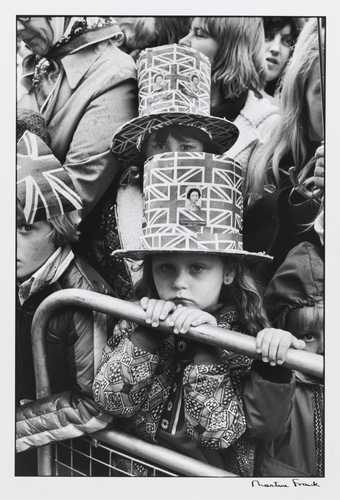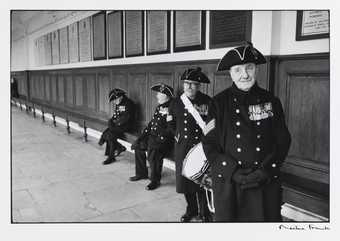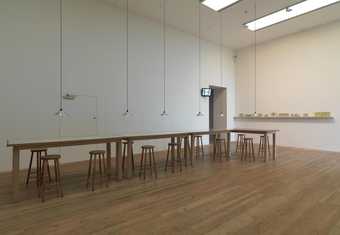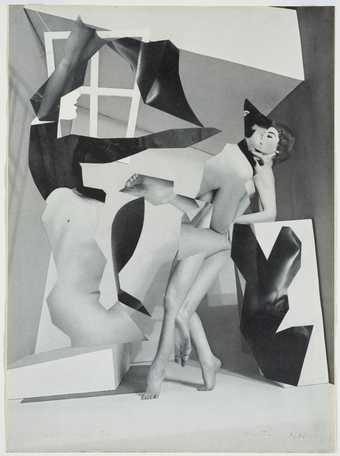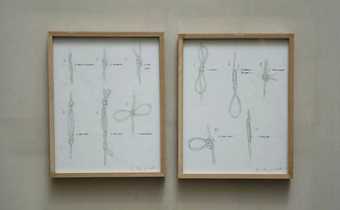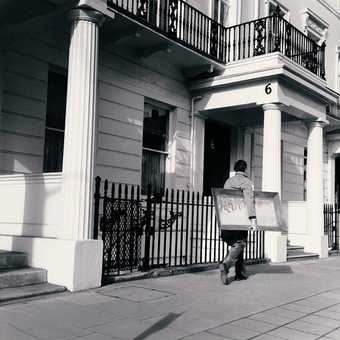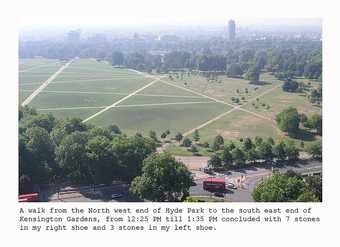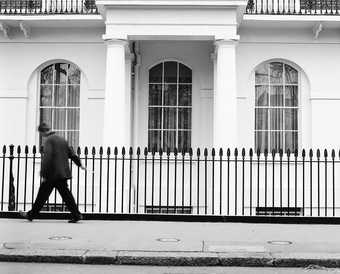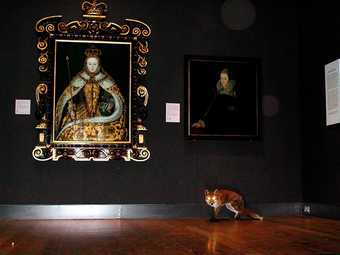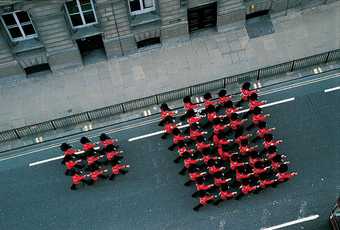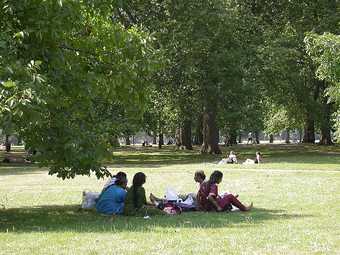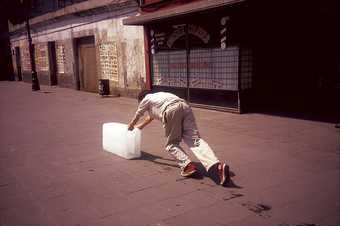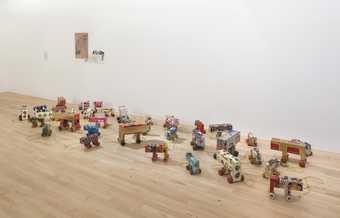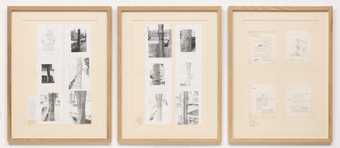
Not on display
- Artist
- Francis Alÿs born 1959
- Medium
- 9 works on paper, photographs, graphite, ink and tape
- Dimensions
- Frame (each): 297 × 236 × 20 mm
displayed: 297 × 2360 × 20 mm - Collection
- Tate
- Acquisition
- Purchased 2006. The Artangel Collection at Tate
- Reference
- T12182
Summary
A Personal Repertoire of Possible Behaviour While Walking the Streets in London Town is a series of nine framed works on paper, which document the artist Francis Alÿs’s walks around London in 2005. The first work contains the typewritten text of the series’ title printed onto white A4 paper and is dated by the artist in pencil underneath, ‘(July 2005)’. The subsequent seven panels are titled with an active verb followed underneath by a list of synonyms. The texts are all written on a typewriter. Six of these panels include a photograph in the upper right hand corner, which provide a visual synonym to complement the list of possible actions. The final work is titled ‘UNCLASSIFIED’ and brings together more disparate actions, such as ‘to bounce’, ‘to fiddle’, ‘to neglect’ and ‘to run’. Displayed together in a horizontal line, these nine works suggest the significant breadth of behaviour observable in a city and the nuances with which these actions can be interpreted. The artist has described how walking through the city allowed him to explore a wide range of behaviours: ‘You are aware or awake to everything that happens in your peripheral vision, the little incidents, smells, images, sounds … Walking brings a rich state of consciousness.’ (Alÿs in 21 Portman Square 2005, p.48.)
The panel titled ‘TO RECEIVE’ does not include a photograph, but contains a typewritten transcript of snatches of conversations Alÿs overheard on London’s Oxford Street over the course of a couple of minutes on 21 July 2005. Alongside seemingly mundane requests for directions and references to the weather are mentions of the attempted bombing that had taken place on the London Underground earlier that day, demonstrating the coexistence of the prosaic and the atypical in a metropolis, and how shifts between the everyday and the anomalous affect the behaviour of a city’s inhabitants.
These works document Alÿs’s own ‘personal’ observations in the city and the use of pencil additions to the typewritten lists imply the ongoing and unfinished nature of the walks. The lists often end with a hyphen or a preposition missing its accompanying verb, which invites the viewer to consider further additions or interpretations. In keeping with the traditions of happenings and Fluxus the works also provide a poetic score for future actions. This is characteristic of Alÿs’s practice and is noted by the writer David Toop:
Ambiguities exist in Alÿs’s work, particularly in the question of documentation that haunts performance… The mixing point of Alÿs’s work comes through files of notes, which collect together drawings, diagrams, textual scribbles. The pages seem to function as a kind of notation in which future actions can be imagined, yet they also seem to be at the heart of the work. Everything is here, and we can imagine outcomes, or sense what might be, or what might have been.
(Toop in 21 Portman Square 2005, p.66.)
A Personal Repertoire of Possible Behaviour While Walking the Streets in London Town is one of nine works in Tate’s collection from Francis Alÿs’s series Seven Walks 2004–5. Over the course of six years Alÿs wandered the streets of London and mapped its habits, rhythms and rituals in a range of different media. In 2005 the ensuing films, videos, paintings and drawings became Seven Walks. Alÿs has used walking as an impetus for making work since early in his career, with further examples in Tate’s collection including Collectors 2006 (Tate T12410) and The Last Clown 1995–2000 (Tate T07993). The addition of the Seven Walks series to the Tate’s collection represents the first time an entire group of works by Alÿs focusing on his exploration of a city have been compiled together. When considering the artist’s practice on the occasion of his 2010 Tate Modern exhibition Francis Alÿs: A Story of Deception, the art critic Coline Milliard noted of this series ‘Alÿs’s walking creates a ground-level image of the city, fragmented, subjective and incomplete. It claims space for the fragile, the ephemeral and the poetic. In a commuter city where pedestrianism fights for survival, “Seven Walks” transforms increasingly alienating surroundings into a new space tailored to human dimensions.’ (Milliard 2010, p.4.)
Further reading
Francis Alÿs: Seven Walks, London 2004–5, exhibition catalogue, 21 Portman Square, London 2005.
Nicholas Whybrown, Art and the City, London 2010.
Coline Milliard, ‘Walks of Life’, Art Monthly, vol.337, June 2010, pp.1–4.
Phoebe Roberts
March 2016
Does this text contain inaccurate information or language that you feel we should improve or change? We would like to hear from you.
Explore
- abstraction(8,615)
-
- non-representational(6,161)
-
- text(1,043)
- periods and styles(5,198)
-
- Georgian(255)
- formal qualities(12,454)
-
- photographic(4,673)
- actions: expressive(2,622)
-
- greeting(89)
- shaking hands(6)
- man(10,453)
- UK countries and regions(24,355)
-
- England(19,202)
- London - non-specific(3,659)
You might like
-
Martine Franck Greenwich, London
1977 -
Martine Franck Chelsea Royal Hospital, London
c.1973, later print -
Francis Alÿs The Last Clown
1995–2000 -
Marcel Mariën Sculpture Friends
1974 -
Francis Alÿs Knots
2005 -
Francis Alÿs The Commuters
2005 -
Francis Alÿs Pebble Walk
1999 -
Francis Alÿs Railings
2004 -
Francis Alÿs The Nightwatch
2004 -
Francis Alÿs Guards
2004 -
Francis Alÿs Sunny/Shady
2004 -
Francis Alÿs Ice 4 Milk
2004–5 -
Francis Alÿs Collectors
2006 -
Richard Wilson Butterfly
2003 -
Hassan Sharif Distance and Time
1983

